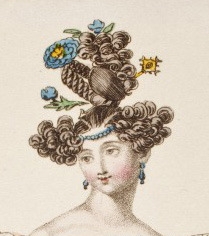The typical process of 1830 hairdressing began by parting the hair into three sections: one shorter one on each side of the forehead and one longer one in the back. The hair’s part is sometimes located in the center, sometimes on the side, and sometimes v-shaped, like this:
The side sections are curled into ringlets with curling tongs (or else with curling papers or cloths), while the back section is yanked (painfully) into those loops and braids and pinned into place. Pomade is used to keep the hair on top and in the back smooth and straight and shiny. Lots of fake hair pieces are used, too, since of course not everyone is equally endowed, hair-wise.




